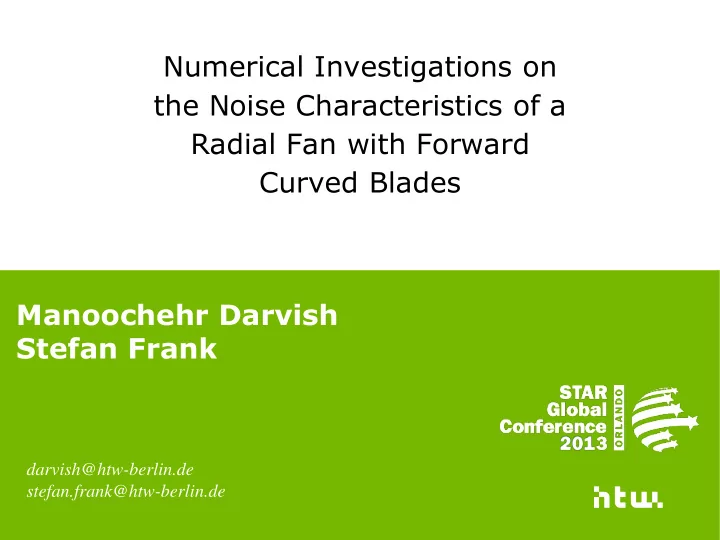

Numerical Investigations on the Noise Characteristics of a Radial Fan with Forward Curved Blades Manoochehr Darvish Stefan Frank darvish@htw-berlin.de stefan.frank@htw-berlin.de
Contents Introduction to FC Blade Fans Review of some previous results Acoustic measurements CFD/CAA simulations (STAR-CCM+) CAA simulations (ACTRAN) Conclusions Next steps 2
Radial Fan with FC Blades Forward Curved Blades Operation at low speeds Low level of noise Used mainly in small and medium sizes ─ Relatively low efficiency ─ Scroll Housing is required Cordier Diagram Application: ─ Automotive industry ─ HVAC applications ─ Compactness vs. Efficiency 3
The best combination : SST K-Omega + Polyhedral 4
Flow rate= 450 m³/h SST K-Omega Experiment (PIV) Steady Unsteady 5
Anechoic Room with Measuring Duct acc. DIN EN ISO 5136 Turbulence Screen (Sampling Tube) microphone applicable up to v= 40 m/s 6
STAR-CCM+ Simulation Simulations start from converged steady solutions RANS (SST K-Omega),DES (2 nd order SST K-Omega ; Hybrid Bounded Central Differencing) ,LES Non-reflecting Inlet/Outlet boundaries (Free-Stream) Segregated solver Compressible flow 2 nd order Temporal Discretization Rotational speed :1000rpm BPF = 16.667 * 38 ~ 633 Hz Number of blades :38 Time Step becomes gradually smaller : 1 ° ,0.75 ° ,0.5 ° ,0.25 ° rotation of the fan-wheel 7
STAR-CCM+ CFD/CAA Simulation Monitoring the maximum pressure at the inlet & in the fan • discharge FW-H Receiver is placed at the outlet • The whole model is assigned to FW-H Surface (Noise Source) • Exporting the results (Density and Velocity) for CAA • simulations using ACTRAN 8
16.5M Cells 4.5M Cells 7 days/rev 1 day/rev 26.5M Cells 12.5M Cells 10 days/rev 5 days/rev 20 cells per wavelength Polyhedral mesh with 4.5M cells not suitable for CAA 12.5M cells model is a solution adapted mesh 9
Low-Re Wall Resolution 10
Different Turbulence Models Different Flow Features DES RANS LES URANS 11
Proudman Acoustic Power dB (steady RANS) 12
Analyzing different designs using RANS simulations Proudman Acoustic Power dB volume based quadrupole sources Curle Surface Acoustic Power dB surface based dipole sources 13
DES sometimes has nonmonotonic response to grid refinements 75 dB Pressure FW-H Monitor 65 dB 14
75 dB Pressure FW-H Monitor 65 dB 15
CAA simulations with ACTRAN Modal Surface Boundary Condition makes the channel infinite Lighthill Surface brings the acoustic fluctuations flowing from Rotor to the Stator 4-6 Elements/Wave Length Transient CFD solution (.CCM) ACTRAN Tetrahedral mesh (STAR-CCM+) 16
ACTRAN results Contribution of Lighthill Surface (LS) and Lighthill Volume (LV) DES_16.5M inaccurate results DES_26.5M underprediction in the tonal noise 17
ACTRAN results URANS becomes inaccurate in lower range of the frequencies 2 hours (ICFD)+ 1 day (ACTRAN solver) on a single core (2.3 Ghz) 18
Close correlation between STAR-CCM+ and ACTRAN STAR-CCM+ 100 Hz 633 Hz ACTRAN 19
Transient Surface data helps to gain insights into the characteristics that cannot easily be obtained from charts & diagrams Surface Pressure Level (SPL) obtained from DES simulation f=633 Hz 20
Conclusions • Good agreement between experimental and simulation results • URANS and DES are both suitable for the aeroacoustic simulations using STAR-CCM+ • Close correlation between STAR-CCM+ and ACTRAN • Using ACTRAN, DES input results provide more accurate aeroacoustic results (comparing URANS) • All the presented CFD (URANS,DES and LES) and CAA methods (i.e. FW-H, Pressure Monitors and ACTRAN) are going to be used and validated for the other operating points of the fan 21
What’s next: Improving current results Design modifications Noise determination at the inlet side 22
What’s next: 26.5M Cells LES using a finer grid 102M Cells 23
Thank you for your attention!
Recommend
More recommend